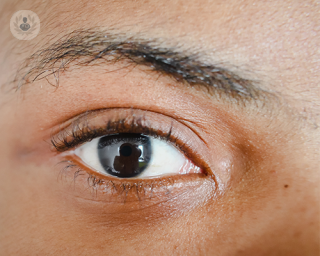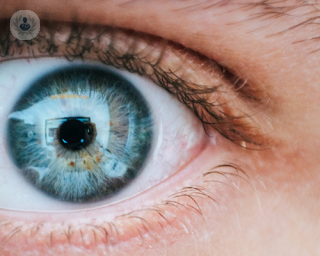What is thyroid eye disease?
Thyroid eye disease (TED) is an autoimmune disease in which the cells that protect us from infections or other aggressive agents act defectively, attacking different organs or tissues of the body such as the thyroid and eyes. In most patients, the same autoimmune disease that causes TED also affects the thyroid gland, which results in Graves’ disease.

What are the symptoms of thyroid eye disease?
The eye muscles, eyelids, tear gland and fatty tissues behind the eyes are inflamed with thyroid eye disease. This leads to red, swollen eyes, which can be pushed forward and leaves the eyes looking as though they are bulging.
In same cases, there is double vision because the swollen eyes mean that the eyes are no longer able to move in line with each other. The eyes may also be watery, intolerant of bright lights, and there are bags under the eyes.
How is thyroid eye disease treated?
If the eyes are teary and you feel uncomfortable looking at bright lights, then artificial tear drops can help the eyes feel more comfortable and protect the surface of your eyes. These can be used with eye drops, gels, and eye ointments. The symptoms should stabilise after six months and it can take up to two years before the inflammation has gone completely.
Inflammation may need treatment with steroids, which can reduce double vision by helping inflamed eye muscles to move more freely. In more severe cases of TED, steroids can help to restore sight. They can be combined with other treatments, such as immunosuppressive agents and radiotherapy.
Some people with thyroid eye disease are left with permanent double vision or the appearance in their eyes has changed. Surgery may be required to treat the double vision and to protect the eyes.
11-13-2012 09-21-2023Thyroid eye disease
Mr Richard Scawn - Ophthalmology
Created on: 11-13-2012
Updated on: 09-21-2023
Edited by: Carlota Pano
What is thyroid eye disease?
Thyroid eye disease (TED) is an autoimmune disease in which the cells that protect us from infections or other aggressive agents act defectively, attacking different organs or tissues of the body such as the thyroid and eyes. In most patients, the same autoimmune disease that causes TED also affects the thyroid gland, which results in Graves’ disease.

What are the symptoms of thyroid eye disease?
The eye muscles, eyelids, tear gland and fatty tissues behind the eyes are inflamed with thyroid eye disease. This leads to red, swollen eyes, which can be pushed forward and leaves the eyes looking as though they are bulging.
In same cases, there is double vision because the swollen eyes mean that the eyes are no longer able to move in line with each other. The eyes may also be watery, intolerant of bright lights, and there are bags under the eyes.
How is thyroid eye disease treated?
If the eyes are teary and you feel uncomfortable looking at bright lights, then artificial tear drops can help the eyes feel more comfortable and protect the surface of your eyes. These can be used with eye drops, gels, and eye ointments. The symptoms should stabilise after six months and it can take up to two years before the inflammation has gone completely.
Inflammation may need treatment with steroids, which can reduce double vision by helping inflamed eye muscles to move more freely. In more severe cases of TED, steroids can help to restore sight. They can be combined with other treatments, such as immunosuppressive agents and radiotherapy.
Some people with thyroid eye disease are left with permanent double vision or the appearance in their eyes has changed. Surgery may be required to treat the double vision and to protect the eyes.


How can thyroid eye disease be treated and stabilised?
By Miss Kimia Ziahosseini
2024-12-19
There are several ways to treat and stabilise thyroid eye disease (TED). Learn about each method from Miss Kimia Ziahosseini, an expert in the condition. See more


What to expect from orbital decompression surgery and recovery
By Miss Kimia Ziahosseini
2024-12-19
Orbital decompression can be vital for patients with severe thyroid eye disease (TED) symptoms. Miss Kimia Ziahosseini, a specialist in TED and its treatment, talks you through the procedure and recovery. See more


What is thyroid eye disease?
By Miss Vickie Lee
2024-12-18
Leading consultant ophthalmic and oculoplastic surgeon Miss Vickie Lee talks through thyroid eye disease, the causes, symptoms, and possible treatments. See more


How to treat thyroid eye disease (TED)
By Mr Jimmy Uddin
2024-12-18
Thyroid eye disease (TED) is a complex eye condition, causing puffy upper and lower lids and protruding eyes. It can be very distressing as it not only affects your eyes but can change the whole appearance of your face, including the skin and eye-brows. Mr Jimmy Uddin, a top consultant ophthalmologist explains more about the symptoms, causes and treatments. See more
Experts in Thyroid eye disease
-
Mr Jimmy Uddin
OphthalmologyExpert in:
- Thyroid eye disease
- Blepharoplasty
- Oculoplastics
- Watery eyes
- Chalazion
- Eyelid cancer
-
Miss Vickie Lee
OphthalmologyExpert in:
- Ptosis (droopy eye)
- Oculoplastics
- Chalazion
- Thyroid eye disease
- Watery eyes
- Dry eye
-
Miss Kimia Ziahosseini
OphthalmologyExpert in:
- Blepharoplasty
- Eyelid cancer
- Ptosis (droopy eye)
- Watery eyes
- Thyroid eye disease
- Facial paralysis
-
Mr Irfan Jeeva
OphthalmologyExpert in:
- Blepharoplasty
- Ptosis (droopy eye)
- Brow lift
- Watery eyes
- Thyroid eye disease
- Eyelid malpositions
- See all

Yorkshire Skin Centre
Yorkshire Skin Centre
1 Sizers Court, Yeadon
No existe teléfono en el centro.
By using the telephone number provided by TOP DOCTORS, you automatically agree to let us use your phone number for statistical and commercial purposes. For further information, read our Privacy Policy
Top Doctors
-
Yorkshire Skin Centre
1 Sizers Court, Yeadon, LeedsExpert in:
- Dermatology
- Clinical Dermatology
- Cosmetic Dermatology
- Facial aesthetics
- Most viewed diseases, medical tests, and treatments
- Visual impairment
- Diabetic retinopathy
- Retina
- Visual stress (Meares-Irlen syndrome)
- Presbyopia
- Nystagmus
- Myopia
- Hyperopia (farsightedness)
- Eye examination
- Demodex





